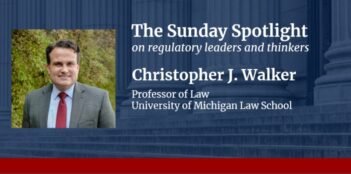
Cost-benefit analysis is the most preferable form of analysis, and it should continue to be employed for important regulatory decisions.
We appreciate Professor Amy Sinden’s thoughtful response to our essay, A Paradigm Shift in the Cost-Benefit State. We agree with some of Professor Sinden’s points, including that agencies have substantial discretion in deciding how to take costs into account. We also do not think that Entergy Corp. v. Riverkeeper compels the use of cost-benefit analysis (CBA). Rather, the Supreme Court applies Chevron deference to “read silences or ambiguities in the language of regulatory statutes as permitting, not forbidding, this type of rational regulation,” as Justice Breyer first suggested in Whitman v. American Trucking Associations.
Although there are other ways that agencies might take costs into account, we believe that cost-benefit analysis is preferable on policy grounds. We believe that the goal of regulation should be to enhance societal well-being. And cost-benefit analysis, despite its limitations, is the most promising tool to achieve that goal. There is bipartisan consensus on this point, which is why every President from Ronald Reagan to Barack Obama has directed regulatory agencies to use CBA. As the Clinton Administration stated in its first Report to Congress on the Costs and Benefits of Federal Regulation:
[R]egulations (like other instruments of government policy) have enormous potential for both good and harm. Well-chosen and carefully crafted regulations can protect consumers from dangerous products and ensure they have information to make informed choices. Such regulations can limit pollution, increase worker safety, discourage unfair business practices, and contribute in many other ways to a safer, healthier, more productive, and more equitable society. Excessive or poorly designed regulations, by contrast, can cause confusion and delay, give rise to unreasonable compliance costs in the form of capital investments, labor and on-going paperwork, retard innovation, reduce productivity, and accidentally distort private incentives.
The only way we know how to distinguish between the regulations that do good and those that cause harm is through careful assessment and evaluation of their benefits and costs. Such analysis can also often be used to redesign harmful regulations so they produce more good than harm and redesign good regulations so they produce even more net benefits.
Yet, despite the strong support for CBA, Professor Sinden seems to view it as the worst form of analysis—an argument to which we might offer the Churchillian rejoinder that it is the worst form of analysis, except for all the others! Although it is true, unfortunately, that there is no perfect approach for developing regulations, Professor Sinden favors alternatives to CBA that are far less satisfactory, such as feasibility analysis. There is strong evidence that feasibility analysis lacks a normative justification, that it should have no place in government regulation, and that it should be replaced by cost-benefit analysis as an exercise of policymaking discretion under the Chevron doctrine, as Riverkeeper allows. For a powerful exposition of these defects, look no further than Jonathan S. Masur and Eric A. Posner’s article, Against Feasibility Analysis.
Professor Sinden also appears to regard “formal” CBA with disdain and as something entirely separate and distinct from “informal” CBA. We think that is misguided. She seems to prefer, instead, some kind of intuitive balancing. Although such an approach may sound appealing, it is extremely open-ended, inconsistent, lacks a normative framework, and presumes extraordinary cognitive capacity and moral clarity of the regulator.
We think that rigorous, quantitative CBA is more clearly viewed as a subset of CBA. CBA is not a black box, but rather a tool for informed decision-making. A “value of information” approach to CBA contemplates the possibility that, in some cases, a rough balancing of benefits and costs satisfies the needs of optimal decision-making. In other cases, optimal decision-making may necessitate robust, quantitative CBA that allows for more granular selection among regulatory approaches. Indeed, Executive Orders 12866 and 13563 governing regulatory review, along with the White House Office of Management and Budget’s CBA guidelines, explicitly recognize that benefits and costs often cannot be rigorously monetized, and even where they can, there may be significant uncertainty in the estimates. Sophisticated use of CBA is much more than a mere arithmetic exercise of toting up numbers to arrive at a regulatory standard. The need for good judgment will never go away, but it is better that judgment be well-informed than not.
Finally, we have to quibble over Professor Sinden’s claim that the Supreme Court for decades had a “presumption against CBA” and maintained one against “formal” CBA in Riverkeeper. A close reading of cases such as American Textile Manufacturers Institute v. Donovan reveals that this purported “presumption” was simply dicta, and Riverkeeper makes that clear. To our knowledge, only one federal court of appeals has ever rejected an agency decision to use CBA as exceeding the agency’s authority—the Second Circuit, in its Riverkeeper ruling—and that decision was roundly reversed by the Supreme Court. In Riverkeeper, the Supreme Court opened the door for agencies to use CBA to implement regulatory programs, stating that statutory “silence is meant to convey nothing more than a refusal to tie the agency’s hands as to whether cost-benefit analysis should be used, and if so to what degree.”
We stand by our view that Congress and the next President should enhance societal well-being by supporting and strengthening the bipartisan tradition of using cost-benefit analysis for important regulatory decisions.
This essay is part of a three-part series, A Debate Over the Use of Cost-Benefit Analysis.





